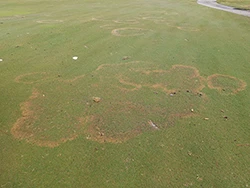
Derek Settle, Ph.D., is a part of the Bayer Green Solutions Team.
 |
| Symptoms of large patch in a fairway. Patches can appear individually or coalesce together. Photo: Derek Settle, Bayer CropScience |
Large Patch Hit Hard in 2014-15: Large patch development favors environmental conditions that are cool and wet. Large patch is one of the most important diseases of warm-season turfgrass species and is caused by the soil-borne fungus Rhizoctonia solani AG 2-2 LP. Symptoms can measure up to 20 feet or more in diameter and zoysiagrass and seashore paspalum are highly susceptible. Bermudagrass is less susceptible, but even bermudagrass fairways and tees were hurt by the disease in 2014-15 when saturated soil conditions became the norm.
 |
| The “orange firing” symptom in the outer expanding edge of large patch. Photo: Derek Settle, Bayer CropScience |
Large Patch Damage is Long Lasting: Large patch can be a difficult disease to control because it requires advanced planning to prevent. Zoysiagrass generally has poor recuperative ability due to its slow growth and this is especially true when temperatures are cool. After damage by the disease, it is not uncommon for residual large patch damage on zoysiagrass fairways to remain visible until June or July, amounting to 8-9 months of turf injury if large patch began the previous fall. Sometimes large patch will continue to blight zoysia into summer as long as conditions remain wet and mild. According to a few superintendents in the Midwest, that’s exactly what happened in early July this year.
 |
| Large patch affecting a fairway. Photo: Zac Reicher, Bayer CropScience |
Large Patch Prevention is Relatively Easy: In the transition zone, large patch is frequently active in both fall and spring when air temperatures are between 50-86 degrees F. In places like Florida, the disease can be active non-stop (fall, winter and spring) because cool temperatures will exist without freezing. Preventive fungicide strategies have been developed over the years to address large patch and are very effective when timed correctly. The first application should be made in the fall when the average soil temperature at a 2-inch depth drops to between 72-75 degrees F. If a summer cools quickly, large patch development could begin as early as August. That said, a temperature-based prediction model will adjust for this.
 |
| Rhizoctonia solani AG 2-2 LP infects the leaf sheath, crown and stolons and not the leaf blades directly. The darkened leaf sheaths and stolons are of Celebration bermudagrass. Derek Settle, Bayer CropScience |
What to Look For: Large patch symptoms can be striking. During active infection, affected turf often occurs in patches that can look yellow, orange or red in color. It can get more striking when the outer edge of the expanding patch becomes bright orange. This symptom has been coined “orange firing.” On an individual plant, the actual site of infection is not on leaf blades, but farther down on the leaf sheaths, crowns, rhizomes and stolons. An infected, off-color plant will easily pull out of the sheath and the stem’s base also will appear water-soaked and rotted, when compared to a white healthy stem.
Key Cultural Strategies: Healthy turf is at the heart of disease prevention. Several cultural strategies can help superintendents decrease the likelihood of large patch development and/or reduce the intensity of disease symptoms.
• Improve drainage in fairway areas, as saturated soils promote large patch
• Avoid over-irrigation – especially in the fall and spring – as this can trigger outbreaks
• Monitor nitrogen fertility closely – excessive nitrogen can increase large patch damage
• Do not time warm-season turf fertility in the spring or fall – schedule in the summer
• Finally, aerification in summer is important to help manage and reduce the number of wet, compact areas caused by site-specific characteristics such as traffic patterns
Fungicide Programs: Fall is the best time to prevent large patch with fungicides, but spring is also an option. When timed correctly, fungicides are very effective in their control of large patch. Many options exist, but the chemistries that are most often recommended fit into three classes: DMI (demethylation-inhibitor), QoI (strobilurin) and SDHI (succinate dehydrogenase inhibitor). Bayer has several fungicides labeled for large patch and two examples include, Mirage Stressgard (DMI) and Prostar 70WG (SDHI).
• Apply first fungicide application in the fall (use 72-75 degree F soil temperature average at a 2-inch depth).
• Make a second application 28 days after the first for improved results.
• The following spring, a third and final application is often recommended so that large patch will not injure or impede zoysia growth prior to summer (use 50 percent green-up to time).
• Large patch can damage turf in the spring when wet conditions prevail. Newer research in the Midwest and Southeast indicates a spring application can provide a good level of control and assist recovery.
Latest from Golf Course Industry
- From the publisher’s pen: Conscientious of a bigger role
- Bernhard and Company partners with Laguna Golf Phuket
- Terre Blanche showcases environmental stewardship
- VIDEO: Introducing our December issue
- Bernhard and Company introduces Soil Scout
- Nu-Pipe donates to GCSAA Foundation’s Centennial Campaign
- GCSAA enhances golf course BMP tool
- Melrose leadership programs sending 18 to 2026 GCSAA Conference and Trade Show





